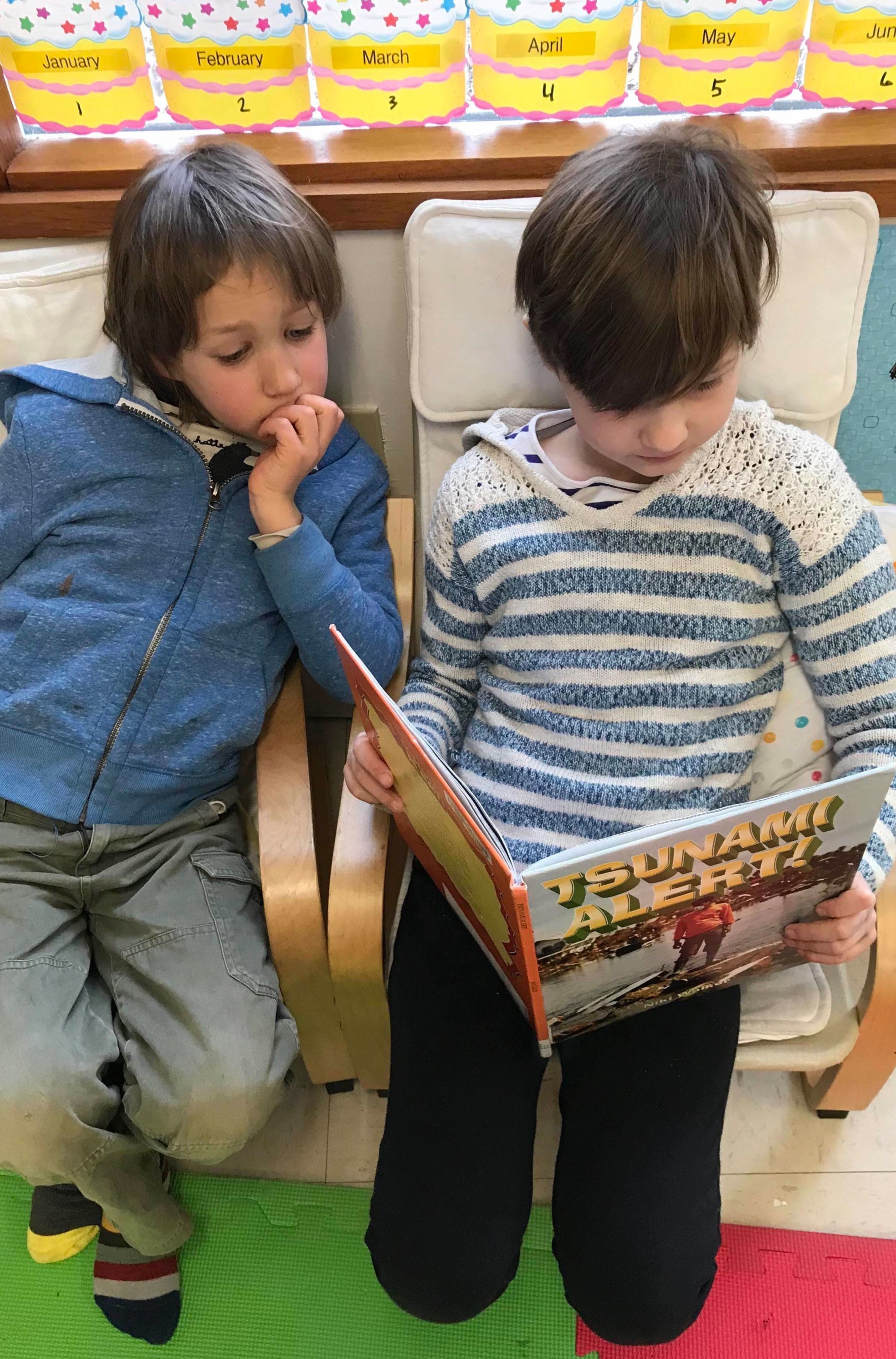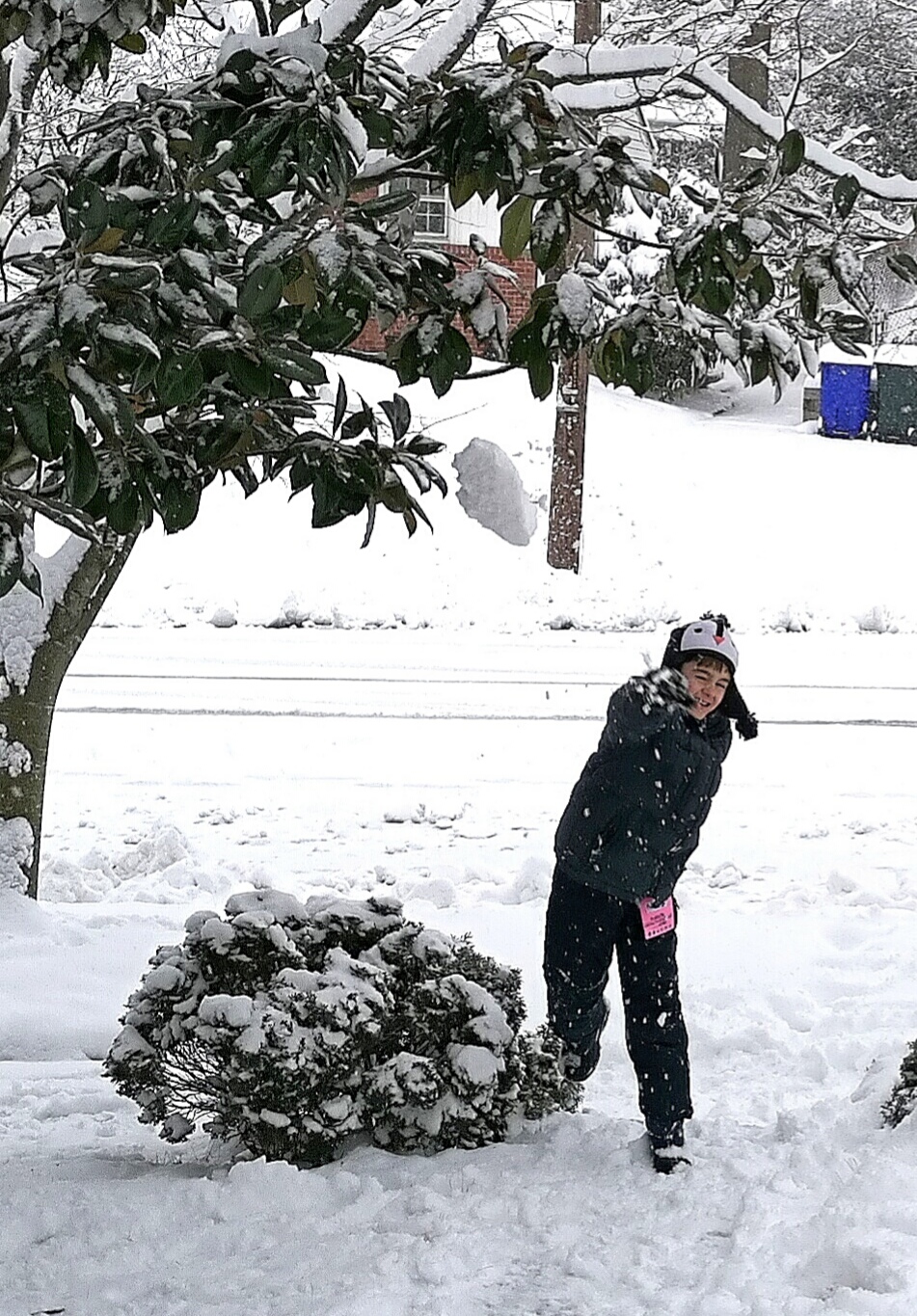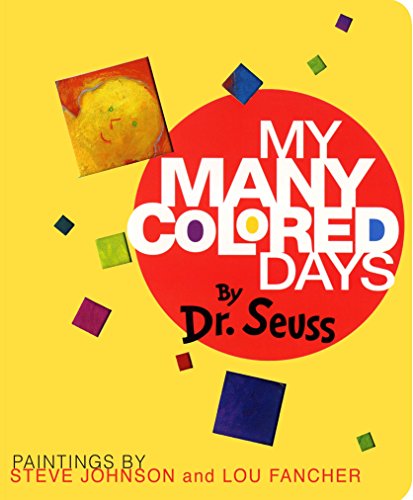Differentiated Math
Alicia (lead teacher of the Oaks): In math, the Tori practiced the “subtract from 10 strategy” (a mental math strategy for 2-digit numbers) and practiced adding three 1-digit numbers. We then talked about equal groups and spent time focusing on the math language that sets us up for multiplication. For example, three groups of 5 equals five groups of 3.
The Ellipsoids practiced mentally adding 1s and 10s to numbers within 100. They also practiced taking some from one number to make the other number 100 in order to mentally add numbers greater than 100. M practiced drawing models to solve pre-algebraic word problems. He also developed his mental math strategies for adding and subtracting numbers to the thousands and mental math for multiplying and dividing a two digit and one digit number
Under Construction
In the playground, the Oaks and Acorns are always busy; digging, hauling, shoveling, balancing and sliding.
What exactly are they making?
We’re not sure…
But we do know that they are; collaborating, negotiating, and planning,
testing, failing, and trying again,
and building friendships.
It’s magical!
Week 25: Tell Me a Story
The Oaks and Acorns listening to and looking at Tar Beach, by Faith Ringgold
Christine (lead teacher of the Acorns): We started an author study of the hilarious and talented Mo Willems this week, which we’ll continue for several weeks. The children are noticing his vocabulary and his illustrations as well as the text features in his books. We are currently reading the elephant and piggie books; Gerald is a reserved elephant and Piggie is a curious pig. Their friendship is dear and the antics are very, very funny. Thus far, we’ve read I Am Invited to a Party!, I’m a Frog!, Watch Me Throw the Ball!, and We Are in a Book!. We’re also learning about Mo Willems’ life. Did you know he started to draw when he was 3 or 4 years old?
Science Thursday: We Heart Science
Hello All,
In honor of Valentine's day, today we talked about the heart. We discussed how it is a pump and what it pumps is blood. We talked about different animals with big hearts, little hearts, many hearts and about animals with no heart at all. The kids all looked at their fists to see the size of their hearts and got to listen to their hearts with stethoscopes.
We looked at a model of the inside of a heart and talked about how the heart pumps deoxygenated blood to the lungs and then out to the body. The acorns had the opportunity to make a heart the size of their own out of play-doh.
Best, Olga
Science Thursday: Climate Change
Hello All,
Today the Oaks and Acorns had a joint science class. We talked about natural climate change throughout time and how the earth started out really hot and eventually cooled. How we have Ice Ages and periods like now cyclicly. We also discussed how animals that can thrive in the Ice Age can have a hard time during interglacial times like now. We also discussed how the Mammoth and Saber cats went extinct due to a change in climate and human predation. I brought up two current examples of animals having a hard time due to climate changes (polar bears in Russia, and seals in Canada).
The kids were then tasked with making their own puppets of animals that might be having a hard time due to changes in their environments. These could be real life animals, imaginary animals, or helping animals that were trying to save those having a hard time. The kids did a great job with their puppets, and I believe had a great time. Hope you enjoyed the creations they brought home.
Have a great weekend, Olga
100 Days of The Great Outdoors
Not one single recess has been held indoors in the entire history of Silver Oaks Cooperative School! Silver Oaks kids are weather proof, and, no doubt, very grateful to their intrepid teachers and co-oping parents who brave the elements so that they can have fun outside come snow, rain, or tsunami!
Week 24: Stormy Weather
Alicia: We launched a new Severe Weather Events unit by reading Cloudy with a Chance of Meatballs. It is one of my favorite tall tales about extraordinary weather events! The children brainstormed different severe weather events, even reaching to weather events on other planets. Today, I posed a research project that will culminate in us filming the children reporting on an extreme weather event in front of a green screen. We overviewed the project and brainstormed questions that we would want to answer in our research.
Tsunami Alert!
In Spanish, we continued asking "Que tiempo hace hoy?" which literally means what weather makes today? (that was a hit!). Our answers (please excuse my English keyboard and lack of punctuation):
Esta nublado, Es una tormenta, Nieva, Hace sol, Llueve, Hace calor/frio
The children can sing Que Llueva independently now and are almost there with De Colores! We read an Elephant and Piggie book in Spanish (another great hit!) and finished dressing our little people for our favorite estacion.
Week 23: Valentine's Day
Christine: On Thursday, Miss Annette hosted a festive Valentine’s Day morning, filled with economics, social studies and fizzy hearts. The children made and delivered valentines after shopping for art supplies at the Valentine’s Day store with the money they’d earned doing their jobs at school.
Sweet Valentines!
Valentine's Day Plans
Hello all!
We are starting Economics in social studies. As part of that we are opening a Valentine’s Day store. On Valentine’s Day the kids will spend their money at our store to purchase paper, stickers, glitter, ribbons, etc. in order make Valentines. They will make one for each student and then we will exchange them. So no need to make them at home....we are on it!
— Annette
Today, we made wallets to keep the money we are earning by doing jobs for the school, such as stacking chairs, tidying up the library books or generally helping out. I framed this by reminding the children that we’re all on the same team, and a good teammate helps out the team. The children will have an opportunity to spend the money on Valentine’s Day when Annette will set up a store with all sorts of fun bits to buy.
— Christine
Science Thursday: To the Moon and Back
Hello All,
In science today we discussed why we see different phases of the moon, how the moon orbits the earth and how we see its lit side at different times.
After discussing the moon's phases we talked about how the moon was formed and how moon and earth rocks are similar. We also discussed how the impact of the planet that made the moon also tilted the earth. We used different colored Play-Doh balls to demonstrate this great impact.
The Oaks also got into how the tilt of the earth - and the way that the sun's rays hit the earth - account for why we have seasons and how the southern and northern hemispheres have their summers and winters at different times.
Best,
Olga
Week 22: Good Times
This week, the Oaks read chapters 1-5 of The Invention of Hugo Cabret by Brian Selznick. They defined: “agitated,” “rickety,” “diligently,” and “decrepit.” They made predictions, and started a character study in their new reading binders. We discussed the symbolism of a clock, which is central in the novel. The children thought a clock might symbolize time, hard work, and thinking.
— Alicia (lead teacher of the Oaks)
Week 21: Snow Much Fun!
This week, the Acorns received some very special letters. They came from Antartica, the very south of South America, and some islands in between. They came from PENGUINS.
Actually, they came from the Oaks. But the fact that they arrived in a solid block of ice had some kindergarteners fooled, maybe just for a moment. Each letter was personally addressed, and came from a certain member of a specific species, and from a particular location. Each penguin had some interesting facts to share about its appearance, habits, likes and dislikes.
Did you know that a Gentoo penguin can swim up to 22 mph?
— Rachel (mom to an Oak)
Science Thursday: The Poles
Hello All,
Today we talked about the differences between the Arctic and Antarctica; the weather differences and what animals live in each area. We also discussed how these animals keep warm. How marine animals use blubber to keep warm and how land animals use fur or how each uses a combination. We also did an experiment to see if blubber is buoyant and if it can help animals stay buoyant by putting rocks into bags of vegetable shortening to see if the rocks still sank. We also looked at fur and how animals have guard hairs and an under fur and what each is for. If your child came home with some fur, it is from a mink coat someone was throwing away that I thought the kids would enjoy having.
Have a great weekend, Olga
Week Twenty: Staying Warm
Do you know how penguins stay warm in cold climates? We brainstormed about this using the scientific knowledge we’d learned and made a hypothesis about blubber. Darling then tested her/his hypothesis. First we put one hand in the creek and determined that our hands were cold. So cold that it was difficult to keep our hands in the water for very long. Next, Darling put her/his hand in a bag of blubber (or Crisco) and submerged that hand in the creek. Darling noted the result and then made a conclusion about the purpose of blubber and body warmth. We discussed other animals that have blubber, as well.
— Christine (Lead teacher of the Acorns)
Celebrating Dr. Martin Luther King Jr.
Last week, Christine brought in a box of eggs. The children sat in a circle on the rug while Christine showed them the eggs and asked for their observations. The children noticed that some of the eggs were brown, some white, some large, and some small. One had freckles. Then, she cracked the eggs and swirled them around in a bowl. Could we tell which ones were the white eggs and which were the brown? No, said the kids, they’re all eggs.
“One child asked, “Do people still feel that way?” She was referencing the racial clashes of the 1950s and 60s that we’d read about in the book. Sadly, I said, some people still do feel that way, although not as many people as when I was your age.”
Next, Christine gently explained that in the past, people were separated according to the color of their skin. White people did not share their drinking fountains, restaurants, schools, or movie theaters with Black people because they considered themselves to be superior. The Acorns were horrified, the Oaks, exasperated. Then the children heard the story of Dr. King’s life, his work, and his death. It was a serious lesson about hate, and a beautiful lesson about the power of love.
“I have a dream that my four little children will one day live in a nation where they will not be judged by the color of their skin, but by the content of their character.”













































